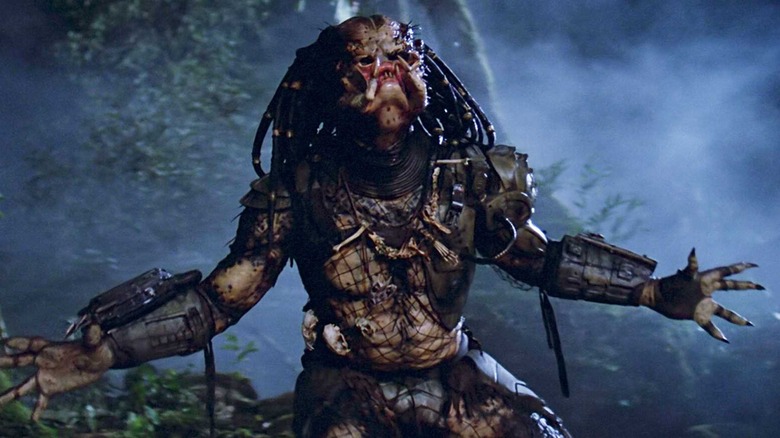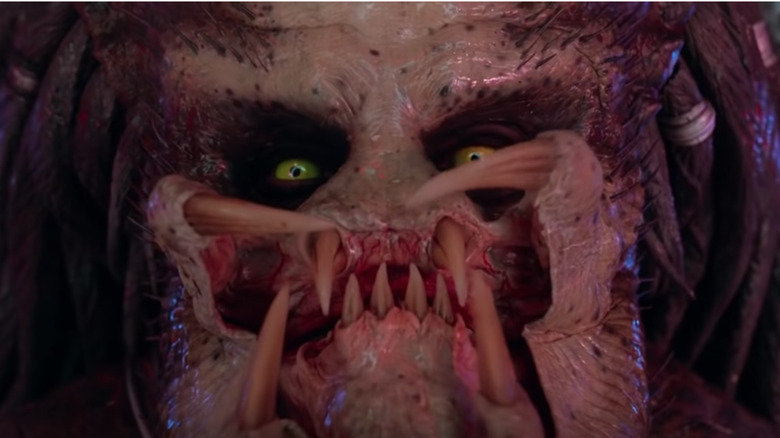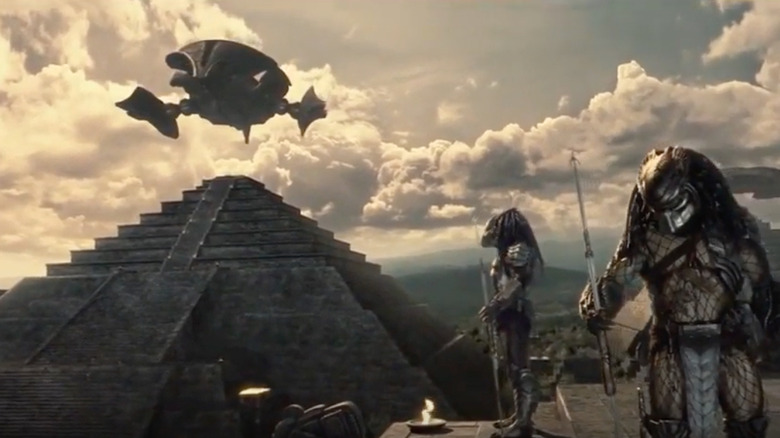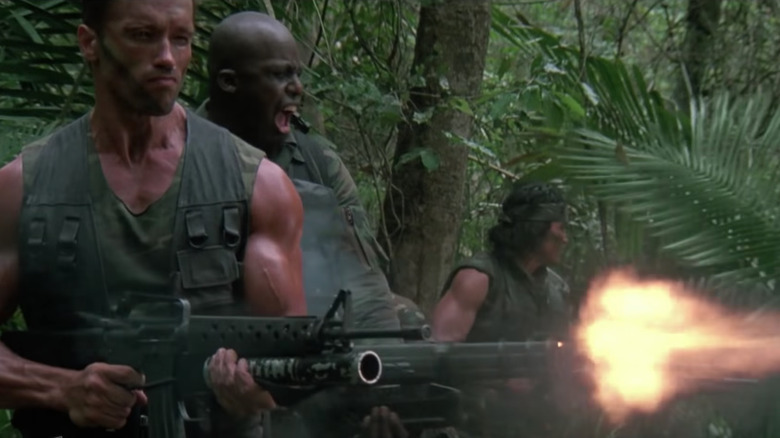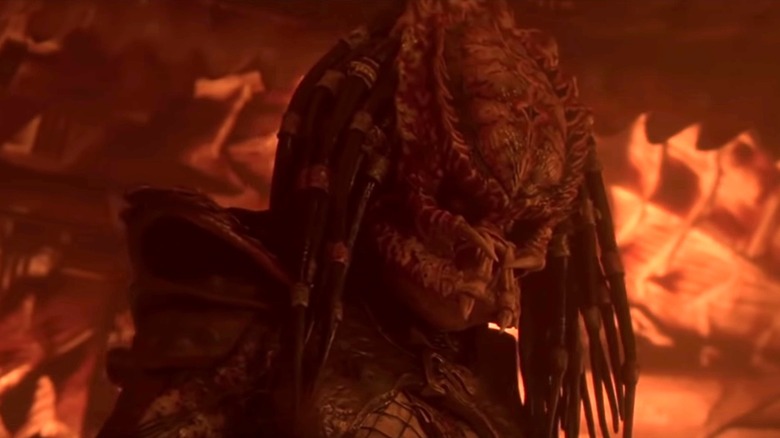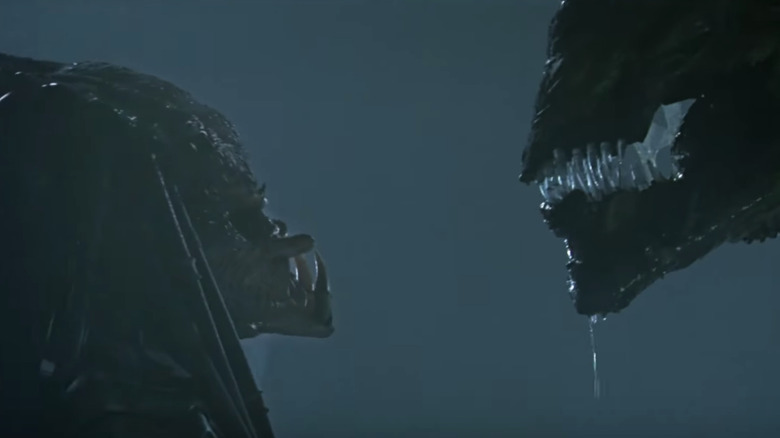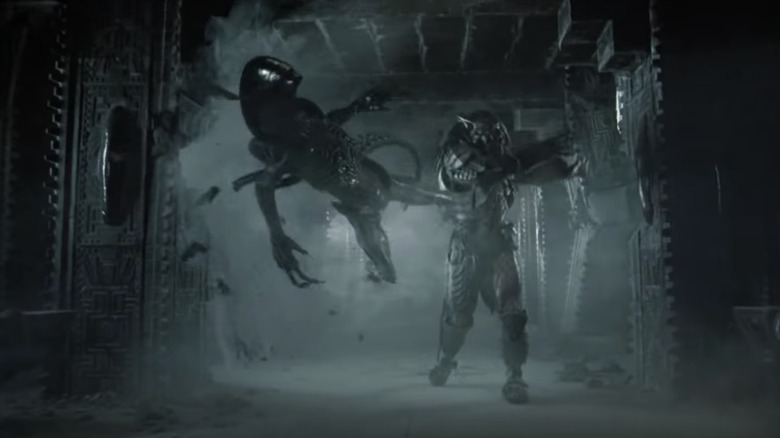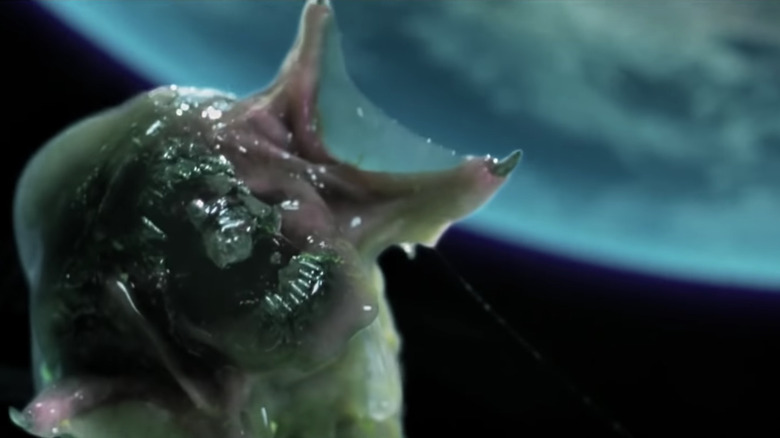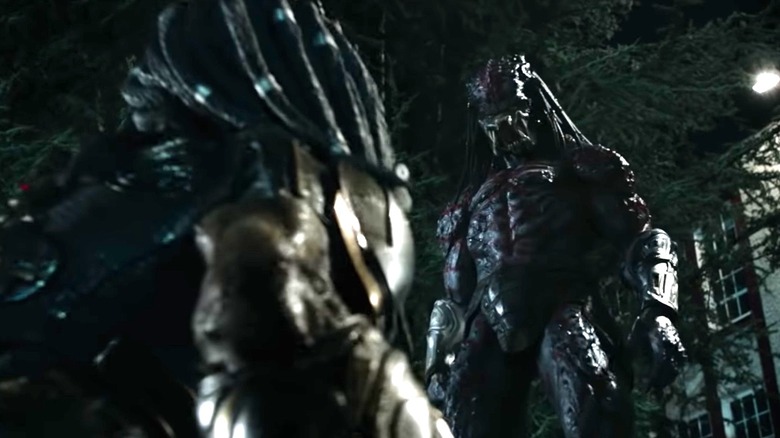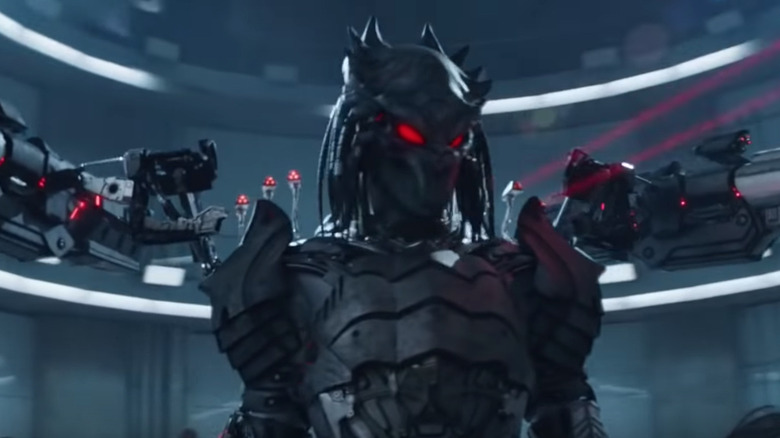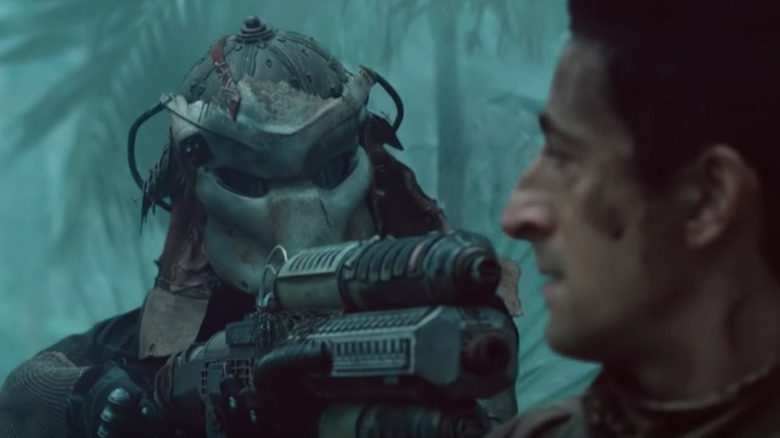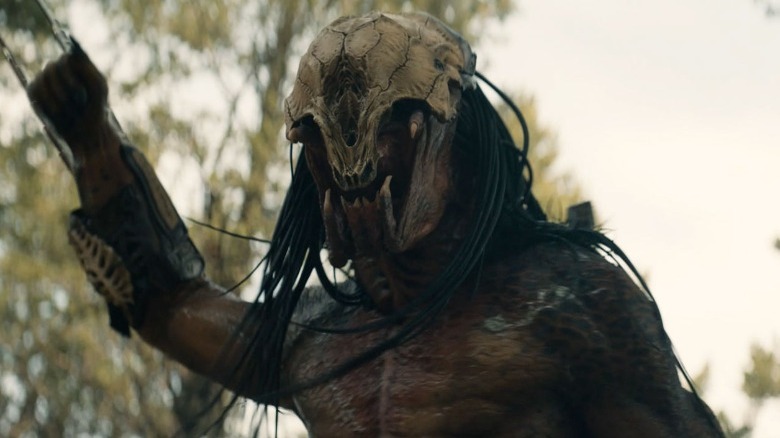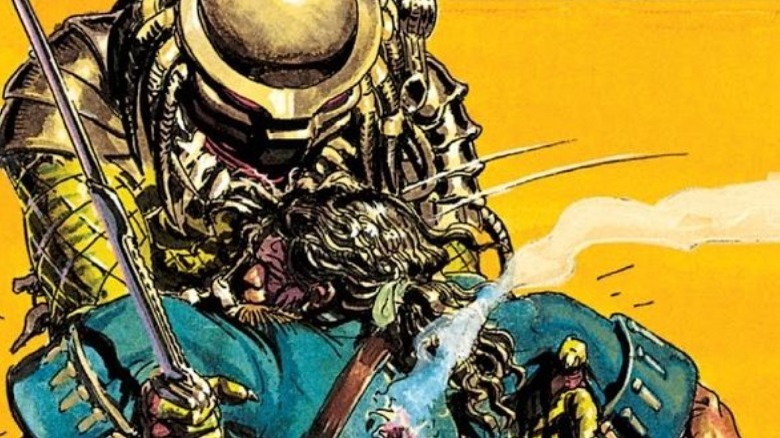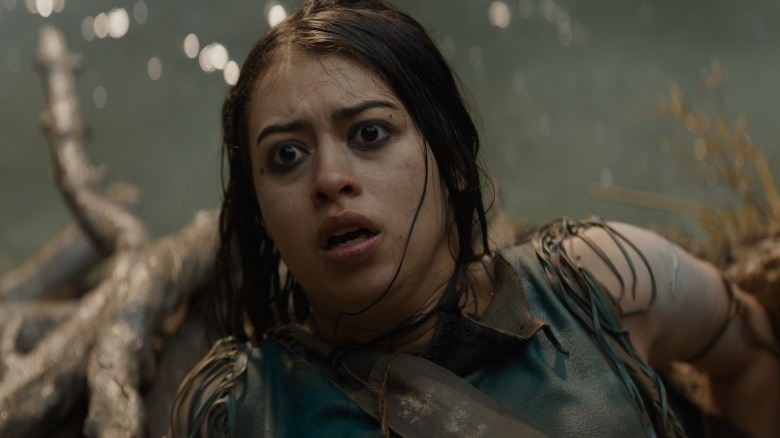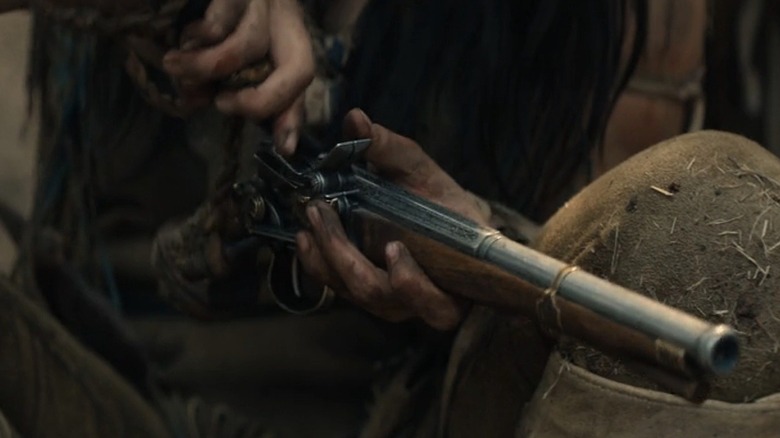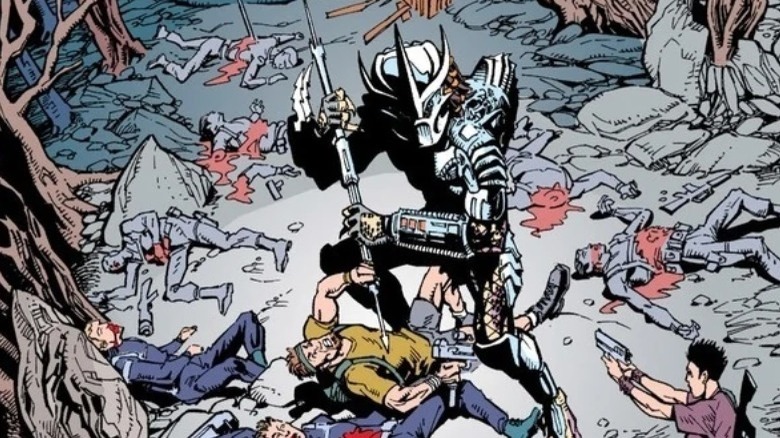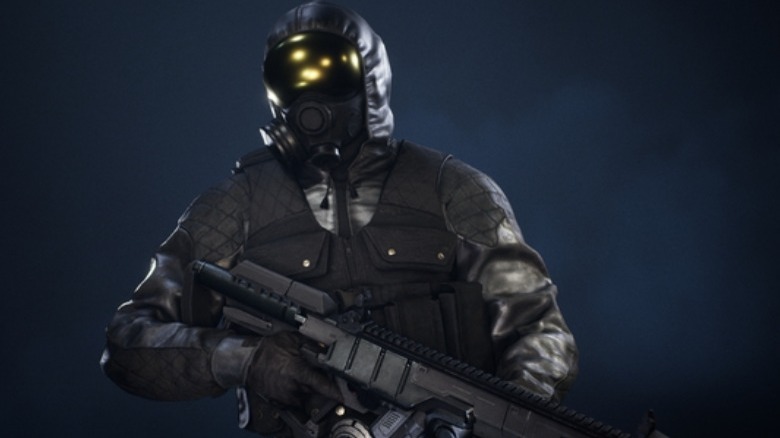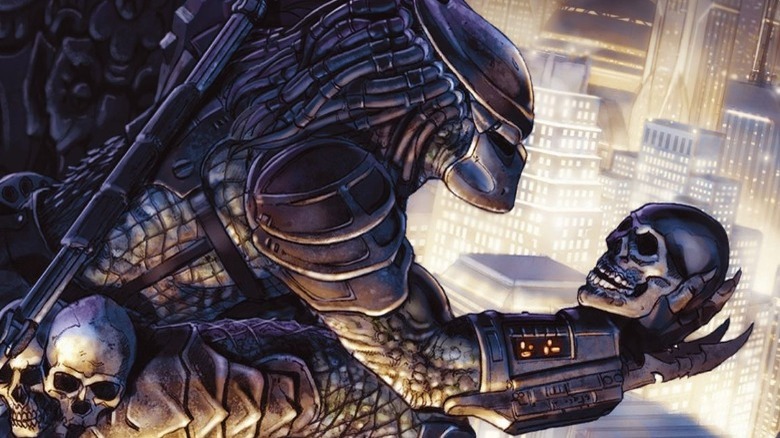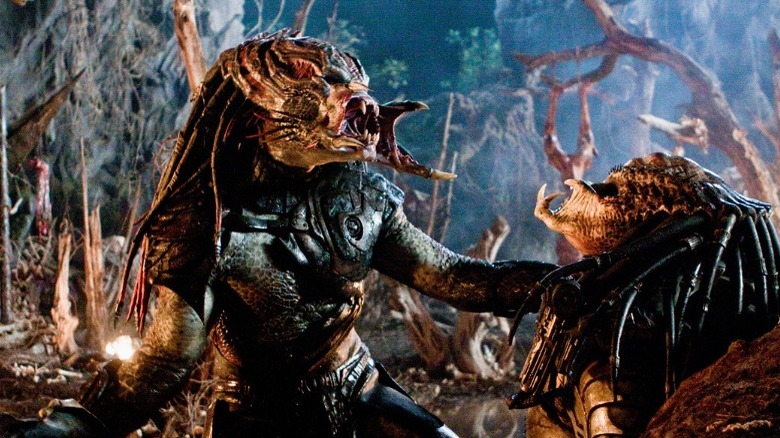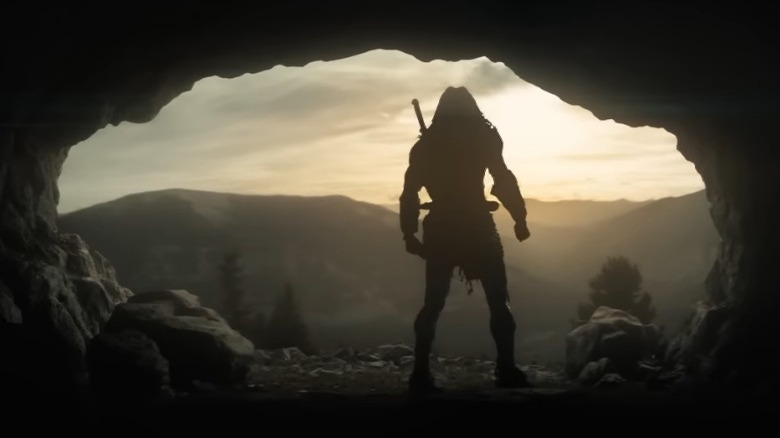The Entire Predator Story Finally Explained
Few science fiction/action movies are more violently satisfying — and confusing — than the "Predator" franchise. Rife with potentially non-canonical adventures, species DNA tampering, and countless blood feuds, things can get pretty hard to follow during the "Predator" movies. What started as a survival-horror story about a group of the toughest commandos 1980s Hollywood could dream up has since blossomed into a franchise that has endured for decades.
Some aspects of the title creature have been carved into the public's consciousness, like its infrared-equipped visor, long dreadlocks, and gnarly mandibles. However, some aspects of the galaxy's greatest race of hunters still remain shrouded in mystery — although with each new installment in the franchise, fans learn a little bit more about these prideful warriors. Unfortunately, it can be hard for even the most diehard fans to keep up with a series that's spent years jumping around in time and canon.
To help "Predator" cinephiles keep track of the sprawling franchise, it's worth going through the timeline and picking out just what fans have learned about the species with each new story. There are a slew of comic books, novels, video games and more that exist to further complicate the Predators' story, so for the purposes of clarity, let's just stick to the film franchise. This is the "Predator" franchise, finally explained.
What is a Predator?
There's a lot we know — and a lot we don't — about the Predators. For example, the word "predator" is just what earthlings call these monsters. Their language appears to be a collection of clicking noises represented through a complex series of dashes in writing, so we don't know what they prefer to be called — at least in the movies, although the "Predator" expanded universe reveals they're known as the Yautja, or the Hish-Qu-Ten. Still, there are a handful of broad strokes that come up throughout each film.
First of all, the race seems to be guided by a desire to hunt for sport. Often they'll seek out whatever passes for the greatest warriors in a given area and stalk them as trophy game (collecting skulls is a bit of a go-to, but not always). They've even been known to pass on human beings that don't pose an immediate threat or challenge, hinting that they might be guided by a twisted sense of honor or sportsmanship.
Typically, they seem to travel in units of no more than three to hunt. When they arrive, they're ready for combat, with elaborate armor designed to help them track prey and turn invisible, and a helmet that allows them to see heat signatures and other highly specific filters on the visual spectrum. If you do manage to get through that armor, you'll be greeted with bright green luminescent blood (assuming they don't self-destruct first).
Where do the Predators come from?
Not much is known about the Predators' place of origin. They're advanced enough to travel the galaxy to hunt the most dangerous species for sport, but they've shown signs of having a singular home world as well as a distinct culture and hierarchy. However, none of that is really explained to any of the human beings that encounter the Predators — they're often too busy running for their lives to swap stories.
Instead, humans typically deal with the warrior class of the Predators — those that are brave enough to leave the stealth ships and put boots on the ground to collect human trophies for sport, honor, or some kind of political power. The Predator species has a sort of tribe mentality and is not above having conflicts amongst themselves. In addition, blood feuds break out when the aliens start to experiment with hybridization as well as some galaxy-spanning eugenics. In short, part of what makes the Predators so scary is the fact that humans don't quite know where they come from or what exactly they want other than to hunt them down and dispatch them with extreme violence.
Sometimes they're hunters, sometimes they're conquerors. Either way, these beasts are just downright scary.
Predator: Welcome to the jungle
The first time we see Predators encountering modern human beings is in 1987, in the jungles of Central America. The first "Predator" film sees U.S. Special Operations Forces veteran Major Alan "Dutch" Schaefer (Arnold Schwarzenegger) lead a group of five highly trained commandos and an old friend from the CIA on a daring mission against some guerrilla troops. After a successful (albeit deceptive) mission, the group learns that they're being stalked by someone or something on their way to their extraction point. One by one, the creature picks off Dutch's men, who rely on their training but are simply no match for their bigger, stronger, and more technologically advanced opponent. However, the armor starts to crack when Dutch realizes that the creature seems to be hunting for sport, ignoring their unarmed female captive.
Dutch instructs her to head to the chopper unarmed while he hangs back. When he's knocked into the mudbank of a river, the Predator has a tough time seeing him because his heat signature has been reduced. Armed with some camouflage and makeshift traps, he engages the creature once more.
Through a series of clever strikes and brute force, Dutch is able to damage the Predator, who takes off its mask in an apparent show of respect before Dutch faces off against the Predator one final time. He then manages to capture the creature in a trap, forcing it to set off a self-destruct bomb to eliminate any trace of its failed hunt.
Predator seeks urban prey
The Predators return years later for 1990's "Predator 2" — and instead of the jungle, one of their number opts to hunt in urban Los Angeles. After witnessing the heroism of police Lt. Michael R. Harrigan (Danny Glover), this Predator proceeds to hunt the cops and robbers in his orbit. Harrigan unknowingly tracks the monster before encountering Agent Peter Keyes (Gary Busey), who informs him that the U.S. government is aware of the extraterrestrial threat posed by the Predators. Keyes reveals the bout with Dutch in Central America was only the latest in a string of encounters in combat zones.
The feds set up a trap for the Predator at a slaughterhouse, revealing that the species feeds on animal meat — meaning they don't hunt for sustenance. Keyes' team springs the trap thinking they have the upper hand by masking their heat signatures. However, the Predator switches to a different view on his helmet and tracks their flashlights. Surprise, surprise, everyone dies but Harrigan.
At another point in the film, the Predator chooses to spare a pregnant woman, despite her being a threat to it. For some reason, they value procreation of Earthlings, but more on that later. Eventually, Harrigan chases the Predator to its ship and engages it in single combat. After he scores a narrow win, several more Predators uncloak themselves and collect their dead comrade's body. They present Harrigan with an antique pistol as a trophy for besting their champion and allow him to leave the ship unharmed before they take off from the planet, seemingly in defeat.
Predator kills that might not count
This is where things get complicated. The same year fans caught a brief glimpse of a Xenomorph skull in "Predator 2," Fox — which owned the "Alien" franchise as well as the "Predator" movies — licensed a series of crossover comics tie-ins that eventually led to the 2004 film "Alien vs. Predator," in which it's revealed that the Predator species arrived in ancient Egypt and helped humans construct the pyramids. In exchange, the people provided sacrifices as hosts for the Xenomorphs so that the Predators could routinely return to Earth to hunt them as some kind of twisted rite of passage.
"Alien vs. Predator" was followed by a sequel, "Aliens vs. Predator: Requiem," but there's an ongoing debate over whether these films count as canon for either franchise. When Ridley Scott returned to the "Alien" franchise for the prequels "Prometheus" and "Alien: Covenant," he ignored the "AvP" story of the Xenomorphs — but the "Predator" franchise seemed unaffected by that, and made winks to the crossover films as late as 2018's "The Predator."
Either way, Predators have a storied history in comic books and other extended material, and the "Alien" crossovers make up a big part of that history. Regardless of the disagreement over whether the films actually happened in each respective universe, since the people behind "Alien" are the ones brushing off the crossover movies and not the people behind "Predator," they definitely count for our purposes here.
The Predator teaches us what pyramids are really for
In 2004, a group of scientists led by industrial tycoon Charles Bishop Weyland (Lance Henriksen) discovers an underground pyramid some 2000 feet beneath the ice in Antarctica. He leads the team on an exploratory mission just as a trio of Predators arrive at the entrance to the pyramid. Through their exploration, they learn that the Predator species rely on the Xenomorphs' ultimate hunt every 100 years to create their prey. Allowing Weyland's team to find it was their clever way of providing hosts for the creatures to spawn in.
The movie, though not well received, provides perhaps the biggest glimpse into the culture and the purpose of the Predators, revealing that early humans worshiped them as gods and willingly allowed the Xenomorphs to spread across the galaxy. It's also heavily implied that the hunt every 100 years is a rite of passage for elite hunters of the species.
Two of the trio sent on the 2004 hunt die quickly while one manages to eradicate this century's Xenomorph threat by befriending a tough-as-nails woman named Alexa Woods. However, it succumbs to its injuries shortly after battling the Queen. As a slew of Predators that had been surveying the conflict appear, they too offer her a weapon as a trophy for her successful fight and leave with their fallen comrade, presumably back to their planet. However, as soon as they leave the dead Predator alone, a Predator/Xenomorph hybrid emerges from its chest to terrorize the ship full of hunters before it even leaves Earth's atmosphere.
The first hybrid Predator experiment
"Alien vs. Predator: Requiem" picks up right after the events of "AvP." With a hybrid onboard (hereby known as the "Predalien"), the ship doesn't last long and crash-lands in Colorado. A lone survivor sends a signal to the Predator home world warning them that the Xenomorph threat persists. One hunter takes it upon himself to go to Earth and eliminate them.
Unfortunately, the sequel focuses heavily on the members of the small Colorado town where the Predator and Predalien have their conflict. As a result, it doesn't do much to further the story of the species other than to highlight the lengths the Predators will go to in order to claim victory over the Xenomorphs. The movie concludes with the Predator facing off against the Predalien in single combat. Both of them inflict mortal wounds on the other before the government drops a tactical nuke on the small town that's now overrun with aliens. Seeing the level of awareness that the U.S. government has regarding the Predator threat after all these years of attacks is interesting, but not necessarily satisfying in terms of explaining the hierarchy of this species.
The film ends with the Predator's plasma blaster falling into the hands of Weyland's corporate partner, Yutani, who declares that the world simply isn't ready for this kind of technology to be unleashed on human beings.
From Predator to hunter-gatherer
Set days before Halloween in 2018, "The Predator" kicks off as a group of soldiers is attacked by a Predator during a mission on foreign soil. U.S. Army Ranger Quinn McKenna (Boyd Holbrook) manages to survive and mail himself some of the creature's armor in order to prove that he actually saw what he saw. He's debriefed and held captive with a ragtag group of other soldiers when the Predator in question wakes up — really, really angry to find itself in a government lab. It escapes, prompting the soldiers to steal a prison bus and set off on a mission to retrieve the mailed armor.
When they arrive at McKenna's house, they find his son took the armor to wear as a makeshift Halloween costume. With the Predator and a couple of never-before-seen quadruped, dog-like Predators on their tail, they track down the boy and retrieve the armor. Unfortunately, the Predator catches up and forces them to surrender the items. It ends up being a moot point, as a larger Predator suddenly shows up and kills the first.
This new, beastly-looking alien reveals through a voice translator that the species has stepped up its hunting game and is now collecting DNA of other species to create stronger hybrids. This puts a target on McKenna's autistic son (Jacob Tremblay), whose trait is desirable for the Predator species.
Armed and dangerous
While "The Predator" may seem like another action-packed romp filled with soldiers battling the galaxy's most worthwhile hunters, the film holds a much stronger canonical connection than that. Not only does it reveal that Predators are evolving by using human and other DNA, but it preps the ground for a potential war. It's theorized in the film that, because Predators like a warm climate, global warming is hurling humanity toward becoming the most attractive new hot spot for invasion. It also turns out that the original Predator that attacked McKenna and his gang had human DNA and was delivering a mysterious package to humanity.
The film ends with McKenna and a group of scientists realizing that the package the Predator delivered was left on purpose. Inside is a suit designed to fit on a human body — one that looks like it's made for the specific purpose of combating Predators. It doesn't take long for McKenna to call dibs on the new tech, meaning humanity is now prepared to fight Predators when they come a-hunting.
Suddenly, the human race seems less likely to roll over and die when the genetically enhanced hunters land. It's still unclear what exactly the future holds for Earth after it's armed with this new suit, but we've been given some insight into the Predators' next move.
Big game hunters
2010's "Predators" arrives last chronologically in the series. It's unclear specifically what year "Predators" takes place, but it's after the 2018 adventure, and the story begins when a group of soldiers from all around the world wake up to find themselves in an unfamiliar jungle staring up at an alien sky. After realizing that they're dealing with Predators, they deduce that they've been hand-picked as some of Earth's greatest warriors and brought to some kind of intergalactic game preserve. Their theory is proven right when they discover a madman who has survived on the new planet for "10 seasons" by scavenging and hiding. He also reveals that there is a blood feud between the normal-looking Predators that fans have seen in previous movies and new, larger Predators.
One can deduce that the Predators' DNA splicing eventually went awry, causing a rift among the species. While it seems that the Predators use the game preserve to sharpen their hunting skills, it's also possible that the technology brought to Earth in "The Predator" made it so the planet is no longer a viable hunting ground, which clearly hasn't stopped them from bringing the hunt to their own turf.
Sadly, although two members of the party defeat the monsters, they fail in their mission to get off the planet and back home to safety. As a result, no one on Earth knows about this new strategy of kidnapping humans to hunt off-planet, meaning McKenna's cool new suit may be useless to save humanity after all.
Predator variants continue to expand
Over the years, the "Predator" series has continued to expand to the point that there have now been several different types of Yautja shown on page and screen. Starting with the original classic Jungle Hunter Predator from the 1987 movie, the species has expanded and become incredibly diverse. No two Yautja are identical in shape, size, and personality. The basic form shown in "Predator" provides a basic outline of what you can expect from these hunters, but there are some distinctive variations across all manner of films and comics.
"Predator 2" first introduced two new versions of the familiar Yautja form. "Alien vs. Predator" went on to showcase an older Elder Predator that is larger and more powerful than other members of its species. The crossovers also introduce the Predalien, a morphing of a Xenomorph and Predator that shares traits of both species. Later entries in the franchise included the extra-large Super Predators and various hybrid Predators.
The 2022 film "Prey" also presented fans with a new type of Predator that is more primitive than the ones seen in other installments, using tools and equipment that are not quite as advanced. There's also an even wider variety of genetically mutated and hybrid Yautja species in the various "Predator" comic books and novels.
The Papua New Guinea incident
There are a lot of comics based on the "Predator" series, but the story "Predator 1718" is notable because it takes place just a year before the events of "Prey." Part of the anthology "A Decade of Dark Horse," the story was written by Henry Gilroy and focuses on Raphael Adolini. The pirate captain leads a group of outlaws at the height of the Golden Age of Piracy and encounters a Predator during his travels. While anchored just off Papua New Guinea, Adolini faces a mutiny after he announces his plans to return stolen treasure to the church it was taken from.
Noticing the ensuing battle, the Predator makes its way to the ship and joins forces with Adolini so that it can then best him in single combat. After the crew is defeated, the two prepare to battle when a survivor cowardly shoots his captain in the back. To thank the alien warrior for fighting alongside him, Adolini rewards him with a flintlock pistol that bears his name. As a sign of respect, the Predator gives his short-term ally a proper burial and leaves Earth with the pistol in his possession — something he would later give to Mike Harrigan (Danny Glover) in "Predator 2" several centuries later. With the release of "Prey," however, this comic became non-canon.
The Comanche hunt the Predator in 1719
2022 saw the release of "Prey" on Hulu. The film is a prequel to the "Predator" franchise that takes place hundreds of years before most of the other action in the series. It follows Naru (Amber Midthunder), a healer in the Comanche tribe of the Great Plains who has aspirations of becoming a strong hunter like her brother Taabe (Dakota Beavers). Believing she has seen a mythical creature known as a Thunderbird, which she considers a sign foreshadowing her coming of age, Naru takes part alongside her brother in hunting a mountain lion that has injured several members of the tribe. However, it is later revealed that Naru was mistaken and had actually seen a Predator ship landing in the Great Plains.
Naru and Taabe soon realize that the cougar is not the only deadly threat lurking in the shadows. The previously unseen Predator begins killing animals and humans, leading Naru to try and track it down. At the same time, French fur traders are ransacking the area of its natural resources and eventually also take Naru and Taabe captive to use as bait to lure the Predator out. A bloody confrontation follows, during which the two Comanche warriors manage to escape as the Predator wipes out almost all of the Frenchmen.
Taabe goes on to confront the Predator and, despite fighting bravely, is ultimately killed. Having noticed that the Predator struggles to see those whose heat signatures have been reduced, Naru sets a trap and manages to shoot the mask off the alien hunter, which contains a sophisticated targeting system. Luring the Predator to a bog, Naru is able to kill it with its own technology and return triumphantly to her tribe.
Raphael Adolini's pistol gets a retcon in Prey
When the Predators give Danny Glover's character a flintlock pistol at the end of "Predator 2," many spin-off wheels were turning behind the scenes. The origin story for that particular gun, inscribed with the name "Raphael Adolini," was first told in the comic "Predator 1718." But then "Prey" came along, setting its action one year later and giving the pistol to a different character named Raphael Adolini (Bennett Taylor). Adolini is an Italian translator who's working alongside the French fur trappers. He gives Naru his pistol before the Predator kills him. Obviously, two Raphael Adolinis running around the world of "Predator" one year apart with identical flintlock pistols is too much of a coincidence, even for a sci-fi monster story, so it's safe to assume that the comic book story is no longer canon. Most fans consider "Prey" to effectively retcon the earlier comic anyway.
This begs the question, though, about how the Predator from "Predator 2" came to have the pistol in its possession when it was last seen with Naru. A possible answer to this could come from the post-credits scene of the 2022 film. In this sequence, a series of paintings depict the story of "Prey" and end with several additional Predator ships arriving on Earth. This could suggest that Predators returned to the Comanche tribe and either took the pistol or were given it.
Bad Blood in Yautja society
Although it was not technically the first release in the franchise to show in-fighting between different Predators, "Predator: Bad Blood" did help to solidify the concept before later installments arrived. Evan Dorkin wrote the four-part comic series, which follows a criminal Predator in New Jersey who goes on a killing spree. Unlike other Yautja, this individual is a mindless killer who brutally murders for no reason. The story even reveals it has taken the lives of several other Predators before arriving on Earth.
Having broken the Yautja Honor Code and disgraced itself, the rogue Predator is pursued by an Enforcer Predator, whose sole purpose is to destroy the menace. However, it is not the only pursuer of the Bad Blood Predator. Claude Loudermilk's CIA task force wants to capture the alien to acquire its technology, while a group of former agents sets out to kill the Predator before it can cause more carnage.
Ultimately, "Predator: Bad Blood" has had a lasting effect on the franchise, and ideas introduced in the comic have gone on to inform events in "Predators" and "The Predator," where it appears there is almost a civil war within Yautja society.
The emergence of OWLF
The Other Worldly Life Forms Program — or OWLF for short — is a shadowy CIA organization that is tasked with investigating Predators who have visited Earth. While the group is briefly mentioned in "Predator 2," its exact purpose and mission were never revealed. It wasn't until the release of the video game "Predator: Hunting Grounds" and its prequel novel, "Predator: Stalking Shadows," that more light was shed on OWLF and what it does.
The game, which sees important characters like Arnold Schwarzenegger's Dutch Schaefer from the franchise return, sees four experienced fighters work together to fight against a single Predator in remote locations around the world. Little is revealed in terms of the plot, as "Predator: Hunting Grounds" is a multiplayer title, but the game features the OWLF in a supporting role. It is the 2020 novel by James A. Moore and Mark Morris that really examines the organization.
Meant to bridge the gap between "Predator 2" and the game, "Predator: Stalking Shadows" follows Dutch and Sean Keyes, a significant agent within OWLF. It is revealed throughout the novel that the group aims to capture a live Predator and also take control of advanced technology and weapons for use by the U.S. government. Dutch assembles a new task force within the organization to combat future Predator threats at the end of the story.
Regaining honor across a century
Video games have played a significant role in the "Predator" franchise and helped expand the universe. "Predator: Concrete Jungle" is a 2005 action-adventure game with a story by legendary comic writer Grant Morrison. Though named after another existing "Predator" story, this one has a different plot. It is largely set in a near-future city known as Neonopolis, first starting in the 1930s and following a Predator who has been hunting on Earth. When he is wounded during riots and gang wars and unable to get back to his ship, he activates a self-destruct failsafe on his transport. Crucially, the subsequent explosion fails to kill the Predator and allows humans to capture some of his equipment — reminiscent of the ending of 2018's "The Predator." In "Concrete Jungle," the Predator is then exiled to a hostile alien planet for his failure, seen by his tribe as a great dishonor as he allowed Yautja technology to fall into the hands of humans. A hundred years later, the Predator is given the opportunity to regain his honor by going back to Earth and killing the gangs that now use the stolen technology for their own ends.
The game concludes in "AvP" style with the Predator fighting a horde of Xenomorphs that had been kept captive by one of the gang's leaders as well as biogenetically enhanced Yautja warriors that were captured using the stolen equipment. He eventually manages to succeed and topple the main gang, allowing the Predator to be accepted by his tribe and go back home. Since the "Predator" franchise has such a scattered timeline, it's hard to say if this is a canonical story or not. But the game does reference the "Alien vs. Predator" films as well as the larger and equally convoluted "Alien" movie universe.
Super Predators reign supreme
"Predators" introduced viewers to a new type of Yautja that is larger and more powerful than the original variants. Known as Super Predators, they have a feud with the other Predators and seemingly want to wipe them out, since the Super Predators believe themselves to be the superior members of the Yautja species. As part of the promotion for the 2010 film, 20th Century Fox created a number of short films, including "Crucified," "The Chosen," and "Moments of Extraction."
These three shorts provide some extra backstory to the Super Predators and the characters of "Predators." "The Chosen" is more of a promotional spot than a standalone short film, giving audiences a brief profile of each of the characters brought to the hunting planet in "Predators." "Moments of Extraction" is a motion comic with some live-action elements that follows the events leading up to the kidnapping of four of the characters in "Predators" and explores who they were on Earth. Bookending the short film is narration from Noland (Laurence Fishburne), a survivor the group encounters on the game preserve planet. In the motion comic "Crucified," we see how the Crucified Predator, who is attached to the totem in "Predators," was caught, with the story suggesting that the Super Predators are intent on killing what they feel are inferior variants of their species.
Badlands is the future of the Predator franchise
The future of the "Predator" franchise looks bright following the success of "Prey," and that means that the story will continue with several new upcoming projects. Director Dan Trachtenberg has been clear that he wants the series to explore new ideas and do things that haven't been done before. This will likely mean that the overall story of the franchise will grow in interesting ways that fans might not necessarily be expecting.
Most notably, there have been suggestions about a possible sequel to "Prey." This would make sense given the tease given at the end of the movie, which suggests further Predators visited the Comanche tribe after Naru defeated the Yautja warrior who stalked the Great Plains. However, it is currently unknown whether a sequel is in production and what story it could follow.
Trachtenberg is also returning to the franchise as a director for the standalone project "Badlands." Little is known about the project, which is reportedly a priority for the studio but is being kept under wraps. The film, like "Prey," will have a female lead.
